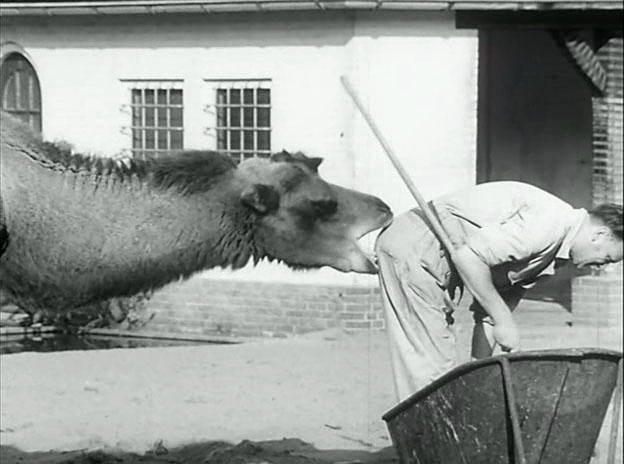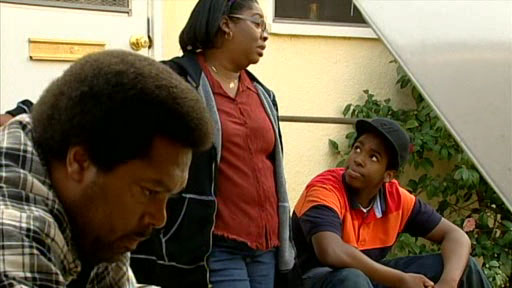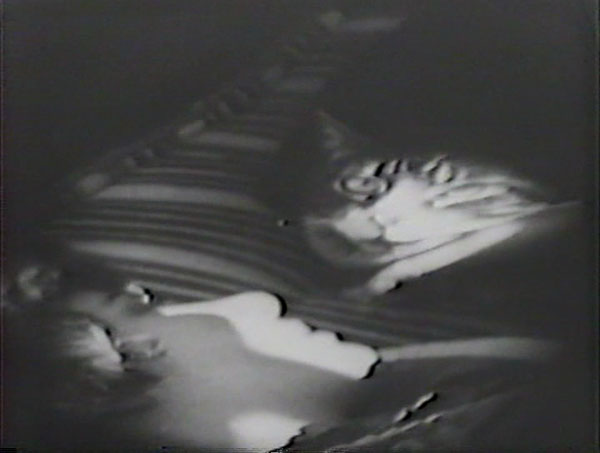A Letter to Uncle Boonmee (2009, Apichatpong Weerasethakul)
Slow-panning shots outside looking in, but mostly inside looking out. Unique location (Nabua village in Thailand) but also unique photography style. I wonder if another filmmaker could’ve found images half as strong as these. As for the story, well, as usual with A.W. I don’t really get it. The village has a history of violence and repression, and this (fictional?) uncle is unseen, addressed by a narrator. Actually it’s more than one narrator, reading the same script, which is later critiqued for accuracy of dialect as we continue roaming the houses, looking slowly up at the trees. Makes me want to catch up with A.W.’s features that I’ve missed. Later: So I have, with Syndromes and a Century. Its dialogue repetition and shots of trees from inside buildings reminded me of this short.
Academic Hack:
In a stunning act of political avant-gardism, Joe has adapted Thai Buddhist tenets regarding reincarnation as a means for excavating the hidden history of a troubled landscape. As his camera slowly creeps and pans through darkened, abandoned homes, Apichatpong is displaying the remnants of a repressed past, in an assertion of ghostly, vertical time. … Joe’s dominant visual cue throughout Boonmee is the depiction of dark, illegible interiors whose porous walls and broken-out windows allow the bright green of the jungle to puncture the once-domestic space with light and texture. As beautiful as the effect may be, it is also chilling, since it represents the breakdown of human effort’s separation from natural encroachment, the dissolution of basic boundaries.
–
We Work Again (1937)
A newsreel short about how “we” (meaning black americans, though it sounds like the regular white studio voiceover guy saying “we”) are finding jobs after the depression – mostly jobs in the arts, thanks to the federal works agency. Contains rare footage of Orson Welles’ “Voodoo Macbeth,” which used all black actors and looks like it could’ve used a higher prop budget.

–
The Little White Cloud That Cried (2009, Guy Maddin)
Commissioned for a Jack Smith program. It reminded me of Kenneth Anger, with the classic pop songs strung together, the soft-focus closeups, but that’s probably because I barely know anything about Jack Smith. Lots (lots!) of nudity, largely (maybe entirely) transsexuals. Typical Maddin editing (which is to say: exhilarating). It’s either art or the best porno I’ve ever seen.

Someone got the filmmaker by accident. He looks so intense!

Send Me To The ‘Lectric Chair (2009, Guy Maddin)
No credits. Need to get a copy someday without interlacing. Made for the Rotterdam festival for an outdoor exhibit. Isabella is in the ‘lectric chair. A man rushes to save her, too late, embraces her as the switch is pulled. Charming homemade effects: tin foil, sparklers and exercise equipment. Louis Negin (reused footage from Glorious?) dances shirtless in celebration!
Maddin: “Now, I was immediately told no nudity, I was immediately told no strobing, so strobing became the new taboo. It would throw the citizens of Rotterdam into epileptic fits flipping on the sidewalks.”

More, from a simply fantastic interview with Maddin: “My condition for doing it was that I got permission to re-use the footage in my next feature. Whenever I accept a short film commission, I get permission to use the footage from it and so I’m slowly assembling clips… and in this financially depressed time, you need to. It’s a Frankenstein feature film built together from a bunch of dead short commissions.”

–
Zoo (1962, Bert Haanstra)
One of the greatest short films ever. He must have shot for days and days to get so many great shots of animals and spectators, then associatively edited them together into a docu-comedy. I learned from the ravingly positive writeup on the official Bert site that it was all filmed with a hidden camera.

–
Contact (2009, Jeremiah Kipp)
Boy and girl visit dealer, get bottled drug and take it together naked. Bad trip ensues. Girl’s concerned parents wait at home, until she shows up late, hugs daddy. Very little spoken dialogue – for artistic sake, or with international film fest distribution in mind? Heavy-handed sound design with echoey shock-horror effects with a sidetrack into 8-bit glitch noise.

–
The Bookworm (1939, Hugh Harman)
The crappiest little time-filler of an MGM cartoon. Can’t imagine anyone wanting to buy these as a set, so may as well parcel ’em out as bonus content on other discs. Poe’s raven wants to catch a bookworm (that’s a worm who eats books) to put in the Macbeth witches’ cauldron, but the worm is saved by characters from other books, with a complete lack of imagination, not even the har-har caricature value of those not-great Tashlin library shorts. Why would the books want to save a bookworm anyway? This seems an important part of the story, and it’s just ignored. Ted on IMDB overthinks the movie, says it’s “amazingly sophisticated in its abstraction,” no kidding. A Tashlin movie would just blow Ted’s head right off. Harman put more effort into the same year’s classic short Peace On Earth.
–
Love On Tap (1939, George Sidney)
At least with The Bookworm you can tune out the story and watch the animation, but there’s no joy in this one. Well, it’s a musical short so I guess you’ve got dancing, but that’s not much of an attraction. Story goes this dude is trying to marry a gal who leads a dance troupe, but her dancers are whiny dependent brats and she caters to their every whim, putting off the guy until he threatens to leave instead of marrying her. He should’ve. Sidney later directed celebrated musicals like Annie Get Your Gun and Kiss Me Kate… guess you gotta start somewhere.
–
Michelangelo Eye to Eye (2004, Michelangelo Antonioni)
Antonioni silently contemplates the work of another Michelangelo. 15 minutes of static or slowly tracking shots, with just room noise until an ethereal choir sings us out into the credits. Nice to see that after all these years, M.A. is still filming people dwarfed by giant structures and pillars.

–
Wake Up, Freak Out, Then Get a Grip (2008, Leo Murray)
A cute cartoon illustrating how we’re all going to die from global warming. Only Leo doesn’t say we’ll all die, he says all the good species of animals will die, leaving rats and roaches, and since there won’t be enough resources left for all of us, those with the most guns and lowest morals will survive to slaughter the rest. Then he says we can’t stop things by being jolly good consumers and buying fluorescent bulbs, we must rather campaign our governments and friendly local corporations to smarten up. Not likely! Move inland.






















